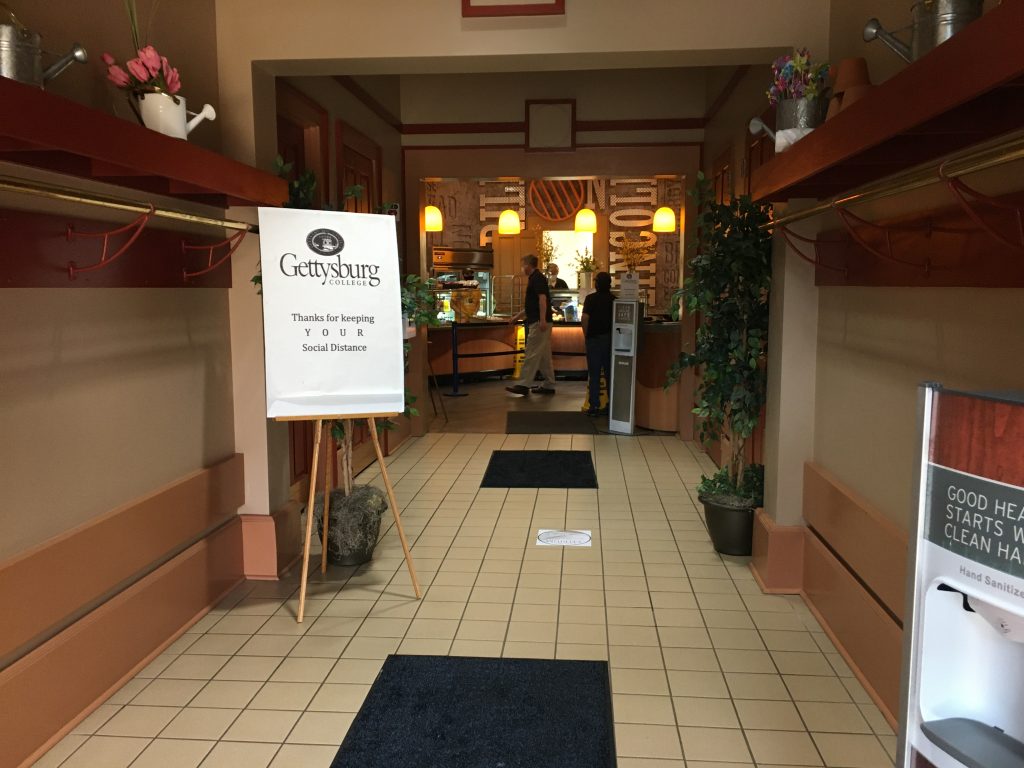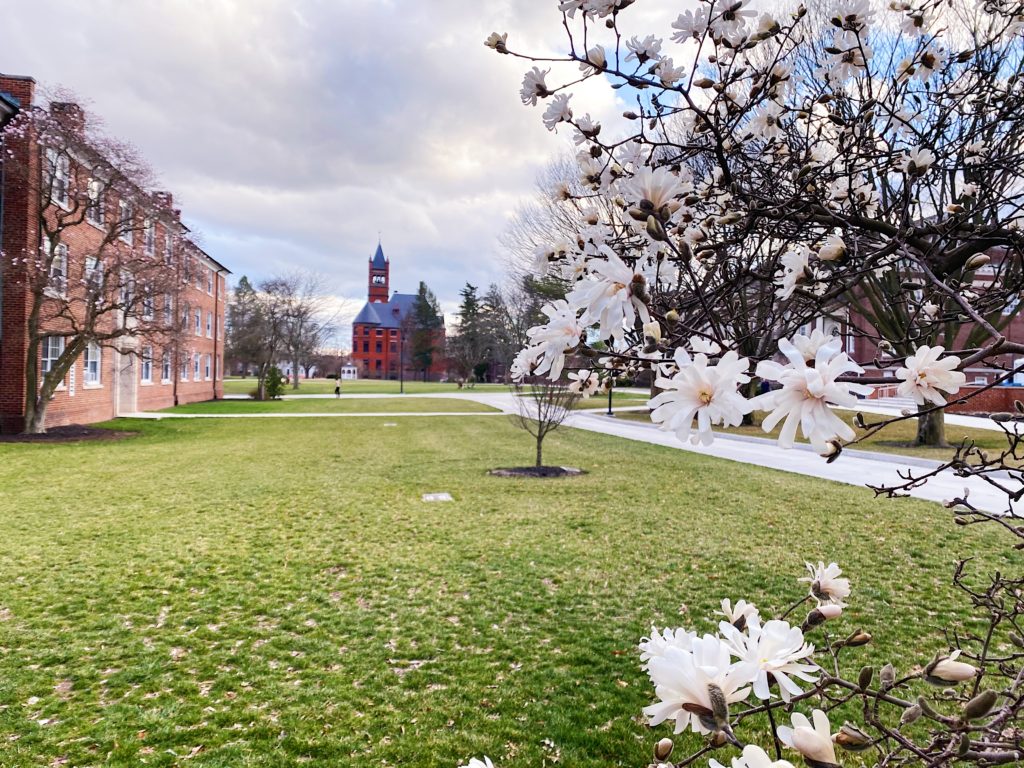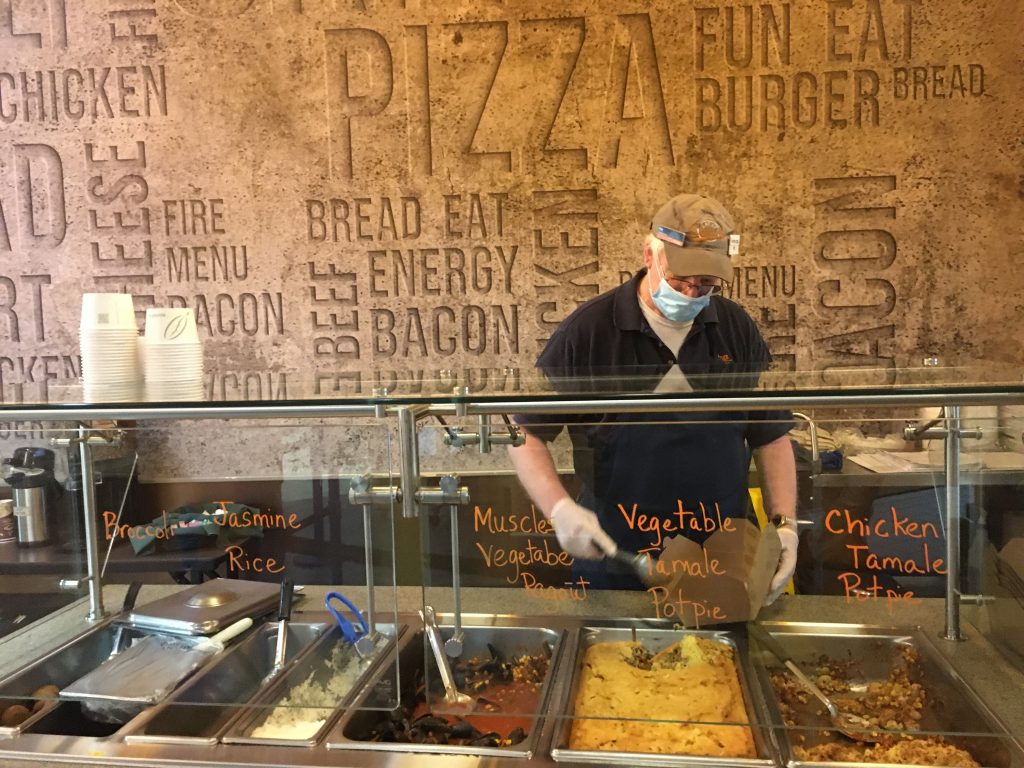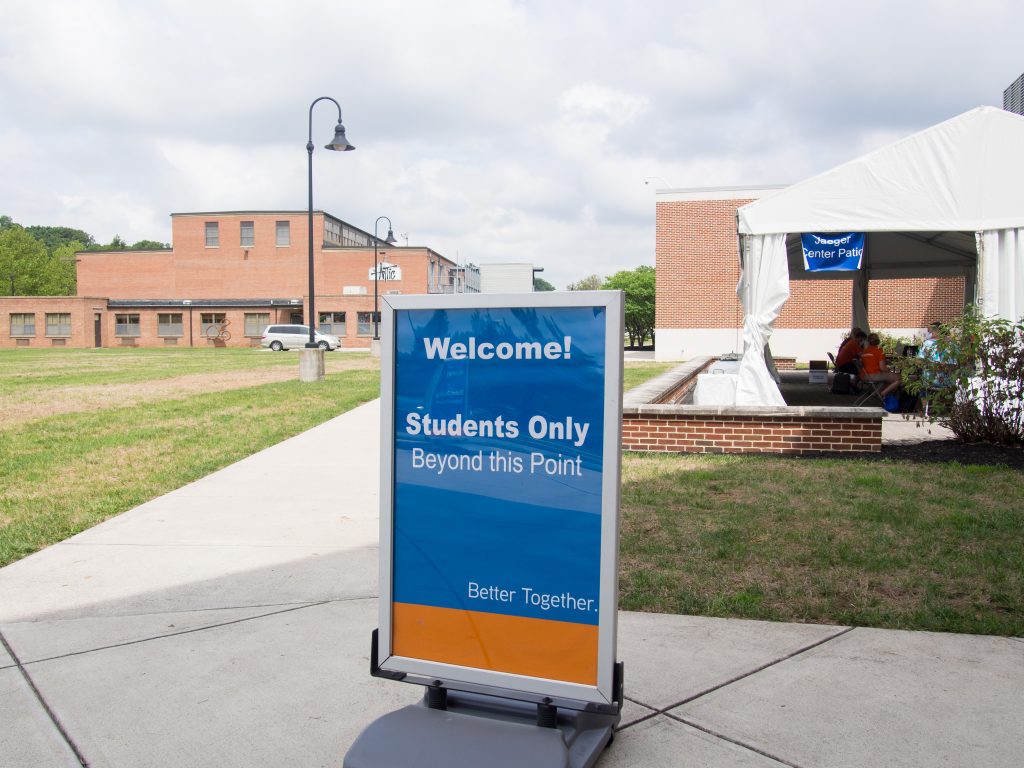What We Learned From the Fall: Unpacking Gettysburg College’s COVID-19 Response
By Anna Cincotta, Editor-in-Chief
On June 22, President Iuliano announced that Gettysburg College would reopen for an in-person fall semester after closing in the spring due to the COVID-19 pandemic. By the time students were made aware of this plan to return to the residential model, intensive preparation was already well underway.
The move-in process began in mid-August, and it seemed as though every aspect and inch of the college had been restructured. Plexiglass shields were installed in academic buildings, tents were purchased to serve as open-air classrooms, and the Gettysburg Hotel became an additional housing option for students in an administrative effort to de-densify residence halls. Keeling & Associates, a consulting firm for institutions of higher education focused on community health and well-being, provided guidance throughout the planning process, and has continued to advise the college throughout the fall.
“I’ve never seen people work so hard in my life,” said the Vice President for College Life and Dean of Students Julie Ramsey.
At first there seemed to be a collective optimism—albeit a cautious one—about the decision to return to the residential model. Only nine students had tested positive for COVID-19 during the initial round of baseline testing. Contract tracing measures were taken, and the semester seemed to be off to a relatively smooth start.
Brendan Cushing-Daniels, Professor of Economics and Harold G. Evans Chair of Eisenhower Leadership Studies, still believes that it was the right decision to bring students back. “I think we could have pulled it off,” he said. “It’s unfortunate that we didn’t.”
Aug. 17 marked the first day of classes. By Sept. 5, over 30 students had tested positive for COVID-10, and on Sept. 12—less than a week later—the total number of positive tests among the student body exceeded 60. 150 students were under quarantine restrictions due to contact tracing efforts, and the need for quarantine capacity quickly became unsustainable as numbers continued to rise.
The college announced its de-densification plan on day 24 of the in-person semester. By day 27, the vast majority of students had been sent home for the remainder of the fall. Only 900 students, including first-years, international students, transfer students, and a small cohort of other groups, would be able to resume their studies in-residence.
Reopening Plans and Changes to College Policies
With the decision to welcome students back to campus also came the need for a reframing of student expectations. Those who decided to return to campus were required to sign a Student Health Agreement outlining the new policies for the semester, including masking, refraining from hosting social events with alcohol, and maintaining six feet of social distance. All students would also have to undergo baseline testing and a two-day quarantine upon arrival, as well as potential surveillance testing in the following weeks. On-campus employees were not given the opportunity to be tested for COVID-19.
In the summer months, during the planning process for reopening, the biggest uncertainties seemed to focus on student responses to the new guidelines. “If it comes to a point where the college is trying to wrangle students, then the challenges are going to be profound by virtue of that,” Iuliano explained.
Dean of Students Julie Ramsey spoke to the significant undertaking of restructuring the college in preparation for a return to residence. “I would liken it to trying to redesign almost every major system of the college in three months,” she said. Ramsey listed off a number of priorities taken into consideration during planning for the fall, including academics, safety, housing, dining, and testing.
Despite the multitude of uncertainties stemming from the pandemic, the vast majority of students decided to return to campus for the fall. In the first faculty meeting of the semester it was announced that only 208 students—less than 10 percent of the student body—had opted to study remotely. 30 students chose to study globally through the Center for Global Education.
Compliance Concerns, Lack of Faculty Testing, and Greek Life Recruitment
For Braden Megathlin ‘21, a Resident Assistant, the fall proved especially difficult due to fear about the spread of the virus in the first-year residence halls. “Being an RA has led to more stress this semester than it has in years prior,” he explained. “While we have been told that our job is not to be ‘the mask police,’ maintaining and enforcing COVID college policies has, for the most part, fallen to us.”
Some members of the faculty shared concerns about bringing the entire student body back at the onset of the semester, including Music Education Professor Brent Talbot. Talbot, who cited his understanding of adolescent and young adult neurological development, had trouble putting full faith into 2,400 seventeen to twenty three-year-olds to make the best decisions on campus 100 percent of the time. He believes that the college should have expected that young adults lacking a fully developed prefrontal cortex—which is in charge of executive function—would not be able to resist large group gatherings without masks.“I wish we had a de-densified model from the start,” Talbot said.
Janelle Wertzberger, Assistant Dean of the Library, expressed concerns about the college’s testing capabilities for the fall. “I was really disappointed that there was no baseline testing for faculty and employees who work on campus,” she said. “I think that testing the people who were coming to campus regularly probably would have been a good idea, if only to identify asymptomatic carriers.”
Despite concerns among faculty and members of the student body about the spread of the virus through social gatherings, Greek Life recruitment took place on Gettysburg’s campus prior to de-densification. While sorority events were exclusively online, fraternities had in-person events with distancing and masking. Still, during the week after recruitment weekend, administrators announced that two chapters would face disciplinary action due to unapproved gatherings that breached health and safety protocols. All Greek pledging events from that point forward, due to the cited health contract violations, were cancelled.
“Delta Gamma is currently on interim suspension as we look into possible violations of the College’s health protocols,” Director of Student Activities & Greek Life Jon Allen said. On Dec. 5, an email was sent out to Phi Gamma Delta (FIJI) alumni announcing the chapter’s suspension until 2023. The suspension was due, primarily, to a chapter house party that took place after all-student quarantine measures were taken in response to rising coronavirus cases on campus.
“Some events just do not lend themselves to six-foot distance,” Ramsey explained. “I would say fraternity parties are right up there at the top of the list.”
‘There Was a Rapidity With Which the Situation Changed’
While the spike in positive COVID-19 tests did not come as a surprise for many members of the campus community, the speed with which the situation unfolded struck some college administrators as sudden and unexpected. “I was surprised by how quickly the compliance piece fell apart from a student perspective,” said Bill Lafferty, Assistant Vice President of College Life and Executive Director of Public Safety. “There was a rapidity with which the situation changed,” Iuliano added.
In July, administrators had already voiced their concern over how new health policies would be enforced among the student body. Still, enforcement of the health contract proved challenging for the Department of Public Safety. According to Lafferty, only fourteen public safety officers were employed by the college during the fall. “That translates to only two or three officers per shift,” he said.
“We were not staffed for this,” added Ramsey. “It’s hard to hire people on a short-term basis, and especially in health care … it was very difficult to find people that we needed to assist us.”
Another issue that emerged in terms of health and safety protocol compliance revolved around enforcing COVID guidelines for Gettysburg students living off campus and renting from private landlords. “We can still hold them accountable, but we can’t go on their property [with the goal] of enforcing policy,” Lafferty said. He also explained that members of the campus community had expressed concern about this loophole.
“I can see how it comes across when Public Safety says, ‘well, we can’t go onto their property but we’ll document the incident, [or] we can’t enforce that in real time.’ I understand that frustration because the belief is that they’re college students, so you should have the ability to enforce college policy anywhere. It’s limiting.”
Ramsey, though expressing that she had high hopes for student conduct, also explained that the college, in hindsight, perhaps should have been more prepared for non-compliance with the agreement. “Maybe we put too much faith in people taking [the Student Health Agreement] seriously. I think we were prepared to give students a little bit of the benefit of the doubt at the beginning, in recognizing that this was a significant transition for students.”

Signs in the dining center remind students to practice social distancing (photo courtesy of Peter Zhang ’21)
Both Ramsey and Lafferty expressed that Gettysburg college students tend to be very social. “All students are social, but I think our students are very social,” Ramsey explained. “I think this is one of their great strengths and, in this case, perhaps a bit of a liability.”
Behind the Decision to De-densify
On Sept. 1, the college placed all students in quarantine after an uptick in cases. Just three days later, the college announced its decision to de-densify.
According to Iuliano, there were three clear reasons behind the choice to send students home so quickly, including concerns about the mental health of quarantined students, the lack of isolation housing available, and the fact that Labor Day weekend would provide students with time to move out without severely disrupting the academic schedule.
“The steps we had to take were really beginning to affect the student experience, and we heard powerfully from students about how much they disliked [the all-campus quarantine],” Iuliano said. “One of the things we committed to doing was giving you a good student experience, and that was not becoming a good student experience,” Iuliano said.
“I started getting lots of concerns from parents about mental health, anxiety issues, and physical health,” Ramsey added.
In addition to concerns surrounding student mental health and well-being, a lack of quarantine capacity also contributed to the quick pivot toward de-densification.
“We’re not really equipped to try to lock down 2,200 students for two weeks,” Ramsey “It’s not something we ever imagined doing, really.”
Following the de-densification announcement, which would allow only 900 students to remain on campus, including the first-year class, students protested on the steps of Penn Hall out of fear and frustration stemming from the news. Iuliano attended this outdoor event to field questions and concerns.

Iuliano addresses student concerns during the protests following the de-densification announcement. (Photo by Nicole DeJacimo)
Other students demonstrated an understanding of the abrupt action taken by the college, including Drew Lemon ‘24. “Had they had a stronger policy earlier, it would have been smoother,” he said. “But I think, given the evolving circumstances, that they did the best with what they could do.”
After the rise in cases, the college followed the advice of public health efforts when making the decision to test all students weekly and move them to singles. “That’s how we ended up [with] 900 students,” Iuliano said. He also expressed that a smaller group of students would be easier to handle.
First-years—who were permitted to remain on campus after many sophomores, juniors, and seniors returned to a remote learning environment—were placed in an unprecedented moment in college history. Both loneliness and relief seemed to be common responses to the de-densification announcement. According to Megathlin, “many felt isolated after moving into singles, and felt stressed and confused by the rapidly changing and sometimes contradictory information that was given.”
When asked about lessons learned from the de-densification process, Iuliano expressed that he would like to prioritize more open communication with the campus community. “I wonder whether there was more we could have said in [the week leading up to the de-densification announcement] that could have begun to explain more of what we were seeing and why our level of concern was rising,” he said. “What we’ve heard clearly from the community is that sometimes it would be helpful to know what’s on our minds, and I think we probably could have done more, [in terms of] communication, than we did.”
Positive cases began to level off after many students returned to remote learning environments, leading to a more manageable situation for everyone involved. Still—by the end of the fall semester, a total of 110 students had tested positive for COVID-19.
An Analysis of the Current Financial Picture: ‘A Rainy Day’ for the College
To put things simply, it hasn’t been an easy year for Gettysburg College—or any college, for that matter. Prior to the pandemic, small liberal arts institutions in the United States were already facing the possibility of closure due to what higher education researchers are characterizing as a threatening demographic cliff. Now, given the hits to college budgets across the country due to the COVID-19 pandemic, as well as the fact that the public health situation lies largely out of the realm of administrative control, the financial picture has already begun to look significantly darker for residential colleges.
Gettysburg is not an exception to this new reality.
After students were sent home to study remotely in the spring of 2020, the college faced a $7 million hole in its budget, due primarily to a partial room and board refund issued to all students. This surprising financial dent, coupled with compounding factors that have painted a complicated financial portrait for the college throughout the past year, leaves Gettysburg on rocky terrain, and without much of a road map.
“Of course, the pandemic is going to have an economic impact on the college,” Iuliano said. “Now, more than ever, I think it’s a call for people who support us to want to find ways to make sure that we can continue to be all that we want to be.” The President also highlighted how the college’s finances have been well-managed over the years. “Again, I’m grateful for the generations of people who preceded me and ensured that we have the resources to deal with a rainy day such as this.”
During the summer and throughout the fall, Iuliano has continued to underscore the fact that resources were not spared in the effort to ensure the health and safety of the campus community. Many actions taken by the college—during the summer, while preparing for the return to residence, and throughout the de-densification process —were costly.
“If we were seeking to preserve resources, we wouldn’t have taken many of the steps we’ve taken,” Iuliano explained. He highlighted the decision to convert the Gettysburg Hotel into a residence hall as an example of Gettysburg’s commitment to reopen safely and responsibly. “It was an expensive judgment to make, but, in our view, a decision that was going to speak to the quality of the student experience.”
After de-densification and the move to remote learning for the majority of students, those studying from home were given a 10 percent tuition reduction as well as a refund for 80 percent of the cost of room and board.
“We will incur a second year of losses when this is said and done,” Iuliano continued, “but we have decided not to cut programs.”
Looking Forward
As the fall semester drew to a close, the college informed the campus community of changes to health and safety protocols for the spring. While sophomores, juniors, and seniors will be permitted to return to campus for a residential experience, new measures will be implemented in an effort to mitigate the spread of the virus.
For one, the college will be working with a new company — Mobile Health — in order to increase its testing capabilities. Students will be tested twice a week, and on-campus employees will be tested before the start of the semester. “Thereafter, a percentage of employees who spend time with students (such as faculty and Health Center employees) will be tested on a weekly basis. Any employee who is named as a close contact to a positive case on campus will also have the opportunity to be tested,” Iuliano said.
In order to prioritize compliance with health and safety protocols, more DPS personnel have been hired in order to handle “COVID enforcement specific duties,” including “monitoring compliance with masking, distancing and gathering,” according to an email to the campus community. “We have also added a full-time COVID-19 Education and Compliance Director to the staff to take the lead on meeting with students regarding reported infractions,” Ramsey explained.
Most students will be housed in single rooms, a choice that—according to the college— will limit the risk of spreading the virus and provide more opportunities for flexibility when it comes to quarantining after testing positive or being identified during the contact tracing process.
Still, the college has continued to adopt a cautious tone when communicating with the campus community. Cold weather brings new challenges, including less opportunities for outdoor classes and dining. The spring, just like the fall, will depend on compliance within the campus community as well as enforcement. “While many members of the community did their part [in the fall], we, collectively, are only as strong as our fellow members,” Dean Ramsey said.
As for predicting the success of the impending spring semester, the campus community will have to adopt a ‘wait and see’ approach. If we know anything for sure at this point, it’s that the situation is unpredictable.
Phoebe Doscher, Gauri Mangala, Katie Oglesby, Jane Fitzpatrick, and Nicole DeJacimo contributed to this article.



